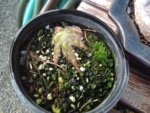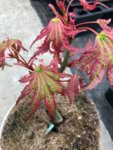River's Edge
Masterpiece
When i was in Japan visiting one of the public gardens i noticed a beautiful maple with tiny leaves in the garden. One of the workers noticed my interest in the seeds and gave me a handful. They are definitely a smaller dwarf type variety, the internodes average 3/8 inch to 1/2 inch apart on most of the seedlings and growth is pretty slow compared to regular maple varieties.
here are some pictures. For perspective the pots are 3 inch and the seedlings are entering growing season two. There is a fair amount of variation but the leaf shape and general color formation is pretty consistent.
Does anyone recognize this type?
here are some pictures. For perspective the pots are 3 inch and the seedlings are entering growing season two. There is a fair amount of variation but the leaf shape and general color formation is pretty consistent.
Does anyone recognize this type?





